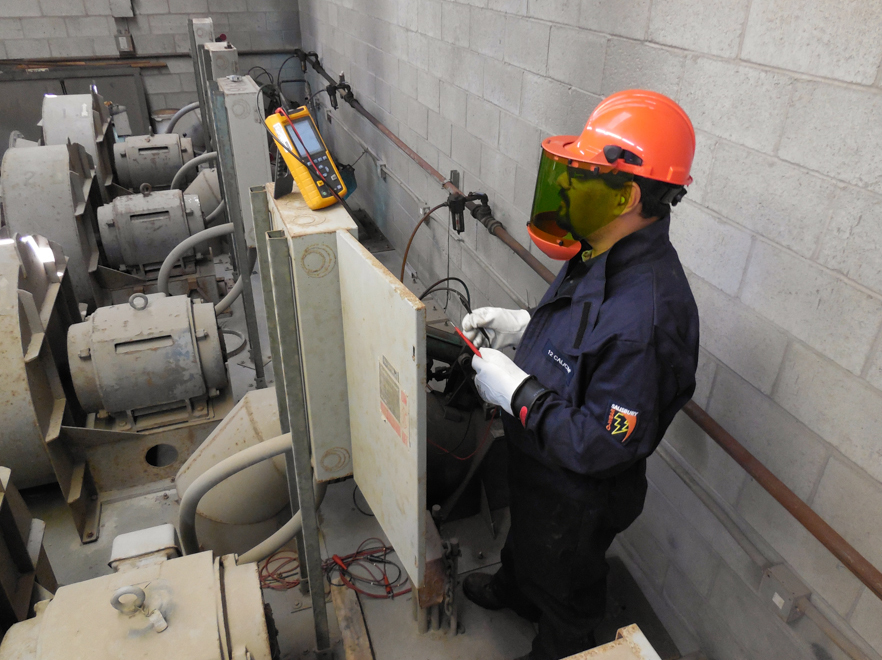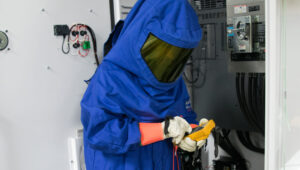Best Practices for Arc Flash Mitigation
In order for your technicians to be safe working on live electrical equipment, you need to employ some version of arc flash mitigation. This is enforced by the 2020 National Electrical Code, Section 240.87. The code applies to any circuit breaker that is rated for or can be adjusted to, 1200 A or higher. In this article, we will look at the many ways you can come into compliance with this particular code.
De-Energizing Equipment
The only way to make sure your technicians are 100% safe from the possibility of arc flash is to make sure the equipment they are working on is de-energized. If the equipment is energized, there is ALWAYS a possibility of an arc flash incident. Working on energized equipment is only allowed when the work cannot be done on de-energized equipment (i.e. current testing), or when de-energizing the equipment is riskier to public health than if it were left energized. These situations require a live work permit, per OSHA standards.
Lock Out Tag Out
Even when equipment is de-energized, there is always a chance that someone could come along and turn the equipment back on in the middle of maintenance. This is why performing a correct lock out tag out procedure is crucial.
There are six steps to a proper Lock Out Tag Out procedure:
- Preparation: Investigate and obtain a complete understanding of all kinds of hazardous energy that might control.
- Shutdown: Shut down or turn off the machine or equipment. Notify all employees affected by the shutdown.
- Isolation: Isolate the machine from any energy source.
- Lockout/Tagout: Lock and tag the machine in a way that the safe position cannot pass to the unsafe position besides by the person performing the lockout. Then tag the device.
- Stored Energy Check: Any potentially hazardous stored or residual energy must be relieved, disconnected, restrained, or made non-hazardous.
- Isolation Verification: Double check that everything is safe, turned off, isolated from power sources, locked/tagged out, and inspected for stored energy.
When it is time to release the LOTO, the employee responsible for initiating it must check the entire workplace to make sure that all people are out of any potential danger areas. They then must remove their personal LOTO devices and notify all affected personnel that the LOTO has been removed and they will be re-energizing the equipment. Only then can they move forward with re-energizing the equipment.
An Instantaneous Override That is Less Than the Available Arcing Current
Most circuit breakers come with a manual override for the instantaneous trip setting. This needs to be set below the prospective arc fault current; this number can be found by determining the acing current and trip curves for your particular device. Most breakers are shipped to site at their minimum setting, which can cause nuisance tripping when power surges from HVAC units, elevators, or exhaust fans. This causes many companies to increase the settings, causing a delay in trip time by as much as a few seconds. This negates the “instantaneous” setting and causes you to fall out of compliance with NEC Section 240.87. This is why many companies choose another method of arc flash mitigation.
Zone Selective Interlocking (ZSI)
ZSI is “A method that allows two or more circuit breakers to communicate with each other so that a short circuit or ground fault will be cleared by the breaker closest to the fault with no intentional delay. Clearing the fault in the shortest time aids in reducing the incident energy.” (NFPA 70E-2015, Standard for Electrical Safety in the Workplace, (Annex O.2.3)) One drawback to this method is that you have a slower response time compared to other readily available technologies.
Arc Flash Reducing Maintenance Switching (ARMS) with Local Status Indicator
ARMS “Allow(s) a worker to set a circuit breaker electronic trip unit or protective relay to operate faster should an arc fault occur while the worker is working within an arc-flash boundary.” (NFPA 70E – 2012) This switch allows the breaker to work as fast as it can, but does not interfere with the built in “as designed” settings already installed in your breaker. It only allows an override when the switch is turned on by a maintenance technician while performing live work. These settings can be turned off after the maintenance is complete. This is most likely your best option for code compliance.
Differential Relays
Differential relays are defined as “The relay that operates when the phasor difference of two or more similar electrical quantities exceeds a predetermined amount.” In layman’s terms this means that if two currents traveling to the same place have too big of a difference in the amount of voltage, the differential relay will send a signal to the circuit upstream of the large voltage stream and shut down power to reduce arc flash incidence. These are more likely to be used in medium voltage applications. These, like ZSI’s, have a slower response time than other applications available.
Energy Reducing Active Arc Flash Mitigation System
This application reduces arcing duration by helping the upstream circuit breaker to open more rapidly. It utilizes relays that sense light, current, etc. and is not intended to be continuously active. It is only used by technicians when performing energized work. It works by interrupting the flow of current with no intentional delay or transfers the current flow to an alternate path. This method is much more expensive than other applications.
Some technicians have concerns with this method. They need extra information such as, where is it located? What calorie level is printed on the label? Is it the level with or without the switch being activated? And how do they know it is in effect if no one tells them?
Approved Equivalent Means
Some technicians believe this was added to the code to “allow for future technology” (2011 ROP 10-82). It was also added to help manufacturing companies without an approved method of arc flash mitigation, be able to continue to sell their previously unapproved methods. Your Authority Having Jurisdiction (AHJ) will be the one who decides if these other unspecified methods are up to code. This promotes more responsibility, diligence, and effort in the electrical inspection community.
Performance Testing
A performance test is required for any arc energy protection system when it is first installed on site. This is to verify that it functions as it is supposed to and will protect you in the event of an arc flash incident.
Keeping your technicians safe should be your number one priority, as well as being in compliance with national code. Here at Energy Management, safety is our number one priority. We are happy to provide you with multiple resources on how to keep your employees and facility safe.
To have an arc flash study performed at your facility, give us a call at 800-595-5315
For more information on Arc Flash Mitigation, watch our EMC Webinars on Arc Flash Fundamentals
Got More Arc Flash Questions? We Can Help!
Call 800-595-5315 Or Connect With Our Expert Technicians Here:
Other Articles
- Lockout/Tagout: An In Depth Look
- How to Assess Your Equipment for Arc Flash Hazards
- Guide to Arc Flash PPE – The Incident Energy Analysis Method



Craig is the Vice President of Engineering at Energy Management Corporation. He is a Professional Engineer (PE) and carries over 30 years of experience in the world of electrical automation. Besides amassing an impressive amount of knowledge in his magnificent brain, he is also a Master Scuba Diver (MSD), a performing magician, and a professional DJ. Truly a man of many talents.






